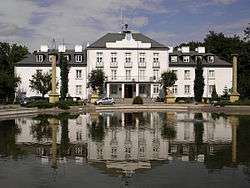Kozienice
Kozienice (Polish pronunciation: [kɔʑɛˈɲit͡sɛ] (![]()
Kozienice | |
|---|---|
 Palace in Kozienice | |
 Coat of arms | |
 Kozienice | |
| Coordinates: 51°35′N 21°34′E | |
| Country | |
| Voivodeship | Masovian |
| County | Kozienice County |
| Gmina | Gmina Kozienice |
| Established | 13th century |
| Town rights | 1322 |
| Government | |
| • Mayor | Piotr Kozłowski |
| Area | |
| • Total | 10.45 km2 (4.03 sq mi) |
| Population (2009) | |
| • Total | 18,075 |
| • Density | 1,700/km2 (4,500/sq mi) |
| Time zone | UTC+1 (CET) |
| • Summer (DST) | UTC+2 (CEST) |
| Postal code | 26-900 |
| Area code(s) | +48 48 |
| Car plates | WKZ |
| Website | http://www.kozienice.pl/ |
Even though Kozienice is part of Lesser Poland, it is situated in the Masovian Voivodeship (since 1999); previously, it was in Radom Voivodeship (1975–1998) and in Kielce Voivodeship (1919–1939, 1945–1975). North-west of Kozienice, in Świerże Górne, Poland's second largest coal-fired thermal Kozienice Power Station is located.
History
History of the town dates back to 1206, when – together with neighboring villages, Kozienice was owned by the Norbertine Nuns from Płock. Subsequently, it used to belong to Polish crown, and remained so until the Partitions of Poland. In 1326 Kozienice was incorporated by King Władysław I the Elbow-high. Located on the ancient road from Kraków to Vilnius and on the edge of the Kozienice Forest, the town became one of favorite retreats of King Władysław II Jagiełło, who founded a church there in 1394. Due to close proximity of the Kozienice Forest and, thus the easily accessible wood supply a pontoon bridge was built over the river, which was later moved to Czerwińsk and used by Polish troops to cross the Vistula (Wisła) between June 30 and July 3, 1410 (see Polish–Lithuanian–Teutonic War).
In 1467, future King Sigismund I the Old was born in Kozienice at a manor house, which is marked by a monument, erected in 1518 (the oldest non-religious monument in Poland). Kozienice was incorporated as a city in 1549, by King Sigismund II Augustus. In 1652, the town was decimated by a cholera outbreak, and four years later, during the Deluge, a battle between Poles and Swedes took place there. In 1782 Kozienice burns in a fire, and due to the efforts of King Stanisław August Poniatowski, the town was rebuilt, and wooden buildings were replaced by stone houses. In 1784-1788, a manufacture, producing rifles, was founded in Kozienice. In 1867, for the first time in history, Kozienice became the seat of a county. A road to Radom was built, as well as barracks of the Imperial Russian Army. In 1897 it was inhabited by 6391 people (including 3764 Jews).
Kozienice gives its name to the protected area called Kozienice Landscape Park.
Jews in Kozienice
Kozienice had a Jewish community with a long history dating back to 1596.[2] Kozienice is pronounced as "Kozhnitz" in Yiddish. In the early 19th century, the Kozhnitzer Magid Yisroel Hopsztajn was one of the pioneers of Hasidism in Poland. He established the Kozhnitz dynasty. In 1856, there were 2,885 people in Kozienice with 1,961 Jews, and in 1897, there were 6,882 people and 3,700 were Jews. Before World War II, about 15,000 souls lived in this region. The Jewish community lived there for about 400 years. The two main industries there were tourism, with Jewish pilgrims visiting the Maggid's tomb, and shoe manufacturing. Kozienice had approximately 5,000 Jews before World War II.[2]
During the invasion of Poland in September 1939, the Germans forced 2,000 Jews into a small local church, where many of them died of suffocation. Kozienice had 15 streets. The Germans established a ghetto in the Fall of 1940 in an area of only three streets. A Jewish Judenrat council was established by the Germans, but most prominent Jews refused to serve. On September 27, 1942, 8,000 Jews from Kozienice and nearby towns were sent to the Treblinka death camp, where they were murdered on arrival. Only 70 - 120 Jews were then left in the Kozienice ghetto, but they were deported in late December 1942 to the Pionki slave labor camp and to Skarzysko Kamienna camp. Some Jews, however, were able to survive the Holocaust by hiding with the Poles. After World War II the survivors emigrated and with time created the Memorial Book of Kozienice,[3] with supplementary List of Martyrs from Kozienice which includes residents of Kozienice killed in Kozienice itself as well as those deported to death camps where they were gassed.[3]
Twin towns — sister cities
Kozienice is twinned with:



References
- Virtual Shtetl: Kozienice
- Krzysztof Urbański (2009). "Kozienice. Historia - Społeczność żydowska przed 1989". Virtual Shtetl (Wirtualny Sztetl), Muzeum Historii Żydów Polskich POLIN.
- Baruch Kaplinski, Zelig Berman, Mordekhai Donnerstein, Ratze Wasserman, Tzvi Madanes, Levi Mandel, Elimelekh Feigenbaum, Leibel Fishstein, David Kestenberg (1985). "Memorial Book of Kozienice". Translation of Sefer Zikaron le-Kehilat Kosznitz. Published in New York: JewishGen web site.
Martyrs of Kozienice (supplement).
CS1 maint: uses authors parameter (link)
External links
| Wikimedia Commons has media related to Kozienice. |
- Urząd Miejski w Kozienicach (2016), Kozienice. Historia 1206–1999 (highlights). Gmina Kozienice
- Sefer Zikaron li-Kehilat Kozhnitz (The book of Kozienice; The birth and the destruction of a Jewish community); Editor: Baruch Kaplinski, Tel Aviv – New York, The Kozienice Organization, 1985 (English, 677 pages)
- Former residents of Kozhnitz in Israel, 1969 (Hebrew and Yiddish, 516 pages)
- The Ghetto in Kozienice by Chaim Dimant, Paris, Yizkor Book Project
- Z okupacyjnych dziejów Kozienic by Mirosław Wasita & Krzysztof Zając on YouTube
